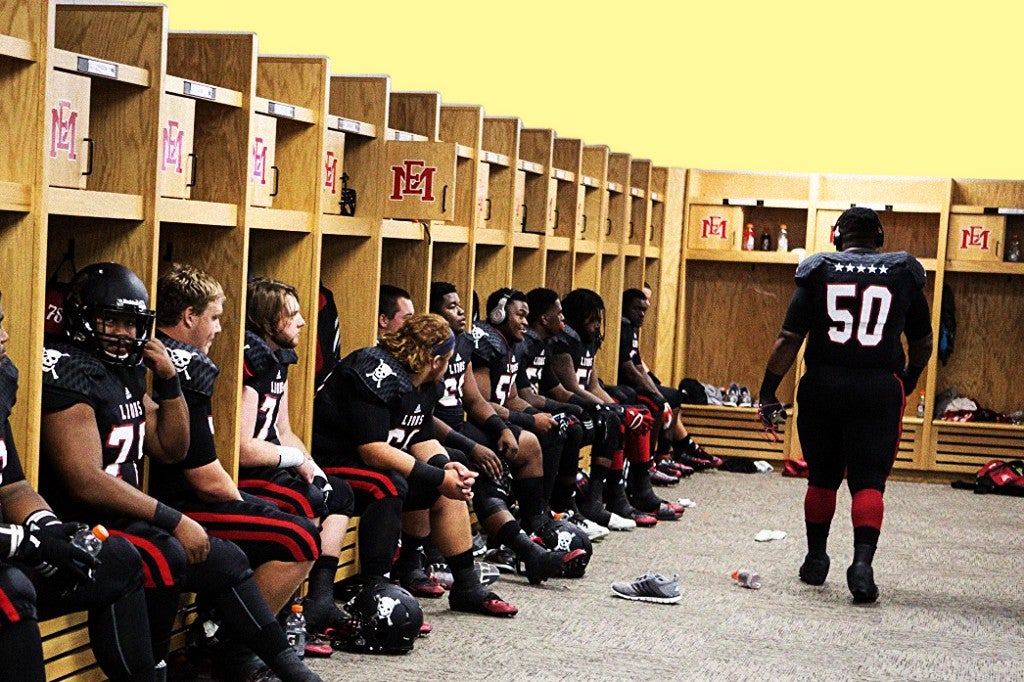I cried during the final scene of Last Chance U.
I’m typically suspicious of such blatant appeals to emotion, but I couldn’t help but feel wistful for the players, coaches and school administrators I’d come to know and admire after binge-watching the Netflix docuseries over the course of the weekend. Which is amazing considering so many of the young men depicted in Last Chance U were at some point considered menaces to society.
I purposefully avoided the first season of Last Chance U after it premiered last year to critical acclaim. Ostensibly, the series is about football, chronicling a season on and off the field at East Mississippi Community College, a junior college football program that has no qualms with being a football factory.
Typically, I’m a sucker for football documentaries, but after years of the NCAA exploiting college players and the growing worry over head injuries, I wasn’t eager to watch a docuseries celebrating a brazenly crass college football program. But what I discovered was a show that addressed the economic and social issues facing football with a shocking amount of honesty, humanity and nuance.
There’s something refreshing about a college football program like EMCC that makes no pretense of being an institution of higher learning. EMCC is mainly a college football halfway house. Many EMCC players are former FBS stars cast out of their universities for gun-, drug- and violence-related incidents, and they attend EMCC with the sole purpose of rehabilitating their images so they can get recruited back into big-time college football. EMCC is more than happy to have them (even if just for a semester).
Keeping the players academically eligible to play is treated like an unfortunate but unavoidable part of winning football games. Much of that responsibility falls on the shoulders of academic counselor Brittany Wagner and mostly involves her buying the players pencils, helping them set their schedules, begging them to attend class, corralling their attention and chastising them when they fail to do simple online assignments.
— Brittany Wagner (@Brittany_MSgirl) August 12, 2017
It’s evident the players adore her. She’s the one authority figure they never talk back to, and they’re more emotionally attached to her than they are any of the coaches (probably because she never calls them “fucking idiots”). But her presence on the show raises the issue of why athletes receive so much preferential academic treatment in the first place. Some of these players are in their 20s, and they still have to be reminded to bring a pencil to class, or how to log into their school email account. Yet the school rewards them with even more resources to help them excel.
Brittany Wagner, savior of all JUCO Football players, I like her. She has FAR more patience than me. I would be telling them, o well! ??♀️
— Your Future Wife?? (@YVEvil_Genius1) July 22, 2017
This idea of accountability, and whether a man is defined by his worst moments, is the beating heart of the show, and plays out with each of the show’s main subjects.
EMCC linebacker Dakota Allen, for instance, joined the team for the 2016 season after being kicked out of Texas Tech University for stealing guns from a private residence. But Last Chance U represents Allen as handsome, charismatic and infinitely calm and respectful. (He’s since rejoined Texas Tech.)
Mood: pic.twitter.com/21I2rNqLUg
— dakota allen (@dakota_allen40) July 18, 2017
Defensive lineman Kam Carter comes across as an erratic, emotionally immature headcase at first. But then you learn he’s clinically depressed; that he was separated from his mom shortly after he was born; and that he was only kicked out of Penn State because he suffers from depression and anxiety, conditions that he self-medicated with weed.
#NewProfilePic pic.twitter.com/MPNl8MfYgu
— ★$☆ KAM CARTER ☆ $★ (@PipeUpKAM5) August 3, 2017
The most harrowing story is that of Isaiah Washington, who goes from star running back to EMCC pariah after a series of injuries — including a concussion and a high ankle sprain — derail his season. His girlfriend has a miscarriage, and we learn he spent his childhood being shuffled between foster homes, many of which were abusive. He eventually loses the attention of FBS recruiters and has to settle for playing at D-II West Georgia.
But the hardest player story to grapple with is De’Andre Johnson’s. Like Allen, Johnson initially comes across as perfectly kind and likable. Then you’re reminded he was the prized Florida State quarterback who was kicked off the team after a security camera caught him punching a woman in the face at a bar.
As head coach Buddy Stephens acknowledges, the only reason Johnson is even given a second chance is because of his exceptional talent. “Let’s be real, if that cat weren’t a really good football player, we wouldn’t be talking to him. But if he weren’t a really good football player, his sorta deal wouldn’t be front page of Sporting News.”
Beneath it all, of course, is the ever-present but unspoken topic of race. All of the players prominently featured in the film are black, while all but one of the coaches and administrators are white. The racial dynamics are made even more uncomfortable by the very nature of college football—where coaches wield absolute authority—and by Stephens’ combative coaching style. He ridicules his players and coaches constantly, alienating them in the process. In one interview, Washington openly accuses Stephens of exploiting his players and being careless with their health. (He’s not wrong.)
With the exception of Wagner, this is far from a white savior story. The Blind Side it is not.
But that’s the point. In each player’s case, Last Chance U doesn’t offer any solutions. It simply lays bare what they’re going through, forcing you to ponder the moral ambiguity of it all.
